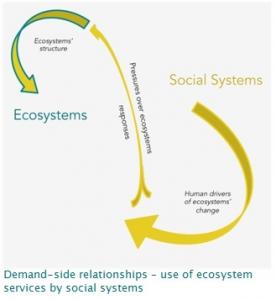An AQUACROSS report on drivers of change and pressures on aquatic ecosystems is available online. An executive summary is also available.
Human activities are resulting in biodiversity loss and ecosystem degradation throughout Europe that threatens the capacity of those ecosystems to provide services to society. The AQUACROSS project identifies two pathways linking the socio-economic and ecological system. In more detail, the two pathways represent two sets of links: the first refers to how ecosystems are linked to human welfare; the second to how socio-economic systems shape and change ecosystems. From a societal perspective, these pathways can be described as the ‘supply side’ (i.e. ecosystems to society) and the ‘demand side’ (i.e. society to ecosystems). A first step to maintaining the provisioning capacity of ecosystems is developing a clear understanding of the complex socio-ecological linkages that ultimately drive biodiversity loss and degradation. The report, ‘Drivers of change and pressures on aquatic ecosystems,’ sets out to offer a common, trans-disciplinary understanding of societal drivers, human activities, and pressures that affect aquatic ecosystems and biodiversity.
This report will support work being conducted in the AQUACROSS case studies by offering practical guidance on how to identify and analyse drivers and pressures affecting ecosystems. In particular, it will help highlight pressures that can induce loss of aquatic biodiversity and change the sustainable supply of ecosystem services. A key focus is building understanding across the aquatic realms of fresh, coastal, and marine water, and across disciplines. Accordingly, the authors take a trans-disciplinary approach to bring together policy-relevant information, screen scientific literature, and identify approaches and indicators. Building on the flows and connections within the social-ecological systems described in Deliverable 3.1 AQUACROSS Concept and Deliverable 3.2 Assessment Framework, Deliverable 4.1 operationalises a driver-pressure-state analysis by:
- Conceptualising how drivers, pressures and environmental states are interdependent in social-ecological systems;
- Defining the drivers of ecosystem change, human activities and the resulting pressures along the freshwater-marine continuum;
- Exploring the existing qualitative and quantitative approaches of driver-pressure-state assessment systems;
- Characterising a suitable set of pressure-sensitive indicators across the different aquatic realms;
- Proposing integrative indicators, especially for newly emerging drivers and pressures, based on currently used cost-effective indicator
The report concludes that the use of consistent terminologies across aquatic realms and scientific disciplines is essential to improved evaluation and understanding. The authors recommend that common indicators, metrics, and indices are used along with linkage framework matrices to link and characterise the relationships and connections from the social to the ecological side of the ecosystem. They conclude that while combined quantitative and qualitative integrative models based on data and expert-knowledge can provide robust policy-relevant information, stakeholders, science, and policy must first agree on what typifies “good” modelling and indicators.
Deliverable 4.1 should be read in parallel with Deliverable 5.1, which analyses causal flow indicators between biodiversity, ecosystem functions, and ecosystem services in the aquatic environment.


